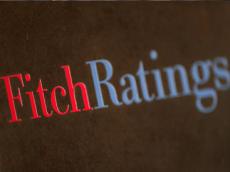|
|
TODAY.AZ / Business
Fitch affirms Azerbaijan Railways at 'BBB-'
25 June 2013 [15:17] - TODAY.AZ
 Fitch Ratings has affirmed Azerbaijan Railways Closed Joint Stock Company's (ADY) Long-term Issuer Default Rating (IDR) at 'BBB-' with a Stable Outlook, Fitch Ratings said today.
Fitch Ratings has affirmed Azerbaijan Railways Closed Joint Stock Company's (ADY) Long-term Issuer Default Rating (IDR) at 'BBB-' with a Stable Outlook, Fitch Ratings said today.ADY is the wholly state-owned operator of the national railway system in Azerbaijan (BBB-/Stable) and its rating is aligned with that of the sovereign. The rating alignment primarily reflects Fitch's assessment of ADY's links with its parent as relatively strong, in accordance with Fitch's Parent and Subsidiary Rating Linkage criteria.
Fitch's assessment considers ADY's high strategic importance to the national economy, including its position in transport of export-bound oil and oil products as well as freight transit, which are significantly contributing to Azerbaijan's economy. The agency also views the operational links as strong due to the government's involvement in tariff setting, capex planning and funding, financial and business strategy and policy setting.
Fitch anticipates that ADY will remain 100% state owned in the foreseeable future, but notes that ADY's debt is not guaranteed by the government.
Debt was relatively modest at AZN284m at end-Q113, including a new loan drawn in February 2013. Currently, ADY does not plan to raise new external debt. Any significant external debt increase, if it was not guaranteed by the government may result in ADY's rating being notched down from the sovereign rating. Additionally, an increased level of secured debt may, in Fitch's view, be detrimental to ADY's senior unsecured creditors (53% of total debt at end-2012) relative to ADY's senior secured creditors (47%).
The agency views the government-approved tangible support in the form of significant committed state funds (both directly from the state budget - USD1.3bn equivalent and borrowed by the state without recourse to ADY - USD450m and EUR215m) for ADY's extensive capex programme over 2010-2017 (USD3bn) as a key factor for the rating alignment. Fitch expects these funds to be contributed to ADY as permanent equity, with the remaining 15% of the capex (and additional maintenance capex that Fitch assumes of around AZN30m p.a.) to be funded from the company's operating cash flows. A change in the proposed funding terms may result in ADY's rating being notched down from the sovereign rating.
In 2012, ADY reported revenue of AZN505m, up 5% yoy. Its EBITDA reached AZN210m, resulting in about 41% EBITDA margin compared with 38% in 2011. Freight revenue accounted for about 66% of total revenue and amounted to AZN335m, with export/import and transit operations accounting for about half each. Flat volumes in 2012 were affected by flat crude oil and natural gas liquids production and certain traffic restrictions imposed due to track rehabilitation works. Average freight tariff increased by 7% in 2012 reflecting the reduction of discounts to SOCAR and strong demand from central Asia producers. Railway traffic is expected to increase significantly upon commissioning of the Baku-Tbilisi-Kars rail link by end-2014, enabling deliveries from Baku to Istanbul and further to Europe.
At end-2012, ADY had gross debt of AZN185m, with 2013 maturities of AZN42m. The debt is made up of an unsecured term loan (funded by loan participation notes) that accounted for AZN98m or 53% of debt and loans of AZN87m secured on export revenues (47% of debt). At end-Q113,gross debt increased to AZN284m, including a new loan drawn in February 2013. Fitch does not currently anticipate funds flow from operations adjusted leverage increasing above 1.5x over the medium term.
At end-2012 cash stood at AZN16m. Fitch forecasts that ADY will report large negative free cash flow (FCF) over 2013-2017 due to its intensive capex programme. ADY is responsible for about 15% of total capex, plus additional maintenance capex that Fitch assumes of around AZN30m annually to be funded from its operating cash flows. Fitch notes that ADY's expansionary capex is only committed to the extent that the earmarked government funds are available. ADY's liquidity excluding this capex is adequate, due to healthy operating cash flow and the amortising structure of about half of its debt.
/Trend/
URL: http://www.today.az/news/business/123931.html
 Print version
Print version
Views: 1133
Connect with us. Get latest news and updates.
See Also
- 03 November 2025 [14:02]
Azerbaijan showcases energy transition experience at ADIPEC 2025 - 02 November 2025 [08:30]
Baku opens door to foreign partners in Zangezur Corridor development - 31 October 2025 [12:35]
EU names Azerbaijan strategic partner in Middle Corridor initiative - 30 October 2025 [12:58]
Azerbaijan, Türkiye sign MoU to strengthen cooperation in insurance sector - 30 October 2025 [12:02]
Azerbaijan and OECD discuss prospects for enhanced cooperation - 29 October 2025 [15:29]
Locations for new energy storage systems revealed in Azerbaijan - 29 October 2025 [15:04]
Azerbaijan strengthens green financing framework for renewable energy projects, says official - 29 October 2025 [14:52]
EBRD supports Azerbaijan in developing national hydrogen energy roadmap - 29 October 2025 [11:43]
Azerbaijan, Xi’an discuss prospects for direct flights and cooperation in transport - 29 October 2025 [10:00]
Azeri Light price declines
Most Popular
 Cologne holds Second Forum of Azerbaijani Engineers in Europe
Cologne holds Second Forum of Azerbaijani Engineers in Europe
 From Qaraba? to Kashmir: How shared struggles unite Pakistan, Azerbaijan
From Qaraba? to Kashmir: How shared struggles unite Pakistan, Azerbaijan
 Vatican hosts Caucasus Muslims Office Chairman for interfaith talks
Vatican hosts Caucasus Muslims Office Chairman for interfaith talks
 Sudan calls for global action over al-Fashir tragedy, draws parallel with Khojaly
Sudan calls for global action over al-Fashir tragedy, draws parallel with Khojaly
 Sheikhulislam Allahshukur Pashazade meets Pope Leo XIV at Vatican
Sheikhulislam Allahshukur Pashazade meets Pope Leo XIV at Vatican
 US mulls ban on popular Wi-Fi routers
US mulls ban on popular Wi-Fi routers
 Tesla recalls Cybertruck electric trucks from customers
Tesla recalls Cybertruck electric trucks from customers
